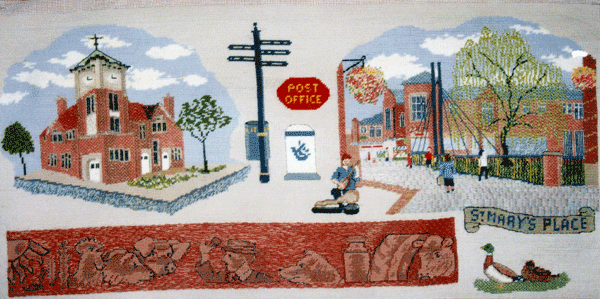| The town has had a
weekly market since at least 1202 and this was originally held in the
centre of the town. In 1902, it was decided to move the livestock market
to a purpose built site off Springfield Street. The Grade II listed
Settling Rooms, designed by HG Coales and HW Johnson, are all that
remain of that market which closed in 1993 and was moved outside the
town. Built in 1902 as refreshment rooms (first and second class),
dining room and kitchen, they were used for settling up after the
auctioneer had completed the selling of stock. Standing in what is now a
supermarket car park, the building has been refurbished and preserved
and is a base for the Volunteer Bureau and Council for Voluntary
Services with a small cafe and exhibition area. Once the livestock
market had moved, the whole area was given over to redevelopment. A new
market hall was built to replace an earlier one built in 1938 and a
whole new shopping precinct was created, opening in 1993. The panel
shows the small suspension bridge crossing the river Welland and linking
the development with St Mary's Road. One of the entrances to the Market
Hall can be seen along with some of the colourful flower and fruit
stalls outside. The Market Hall has 84 stalls inside and has a six foot
high weather vane, designed and made by a local firm depicting the spire
of St Dionysius and the Old Grammar School. The spirit of the market
lives on in a brick sculpture carved into the wall of the supermarket
which shows an auctioneer with his hammer and farm animals (notice the
mouse on the left!). Other modern symbols shown on the panel are, the
Post Office sign, a lottery sign and one of the modern sign posts
complete with litter bin. The busker, John, can often be seen and heard
playing his banjo and the ducks are very much in evidence and at home in
the area.
|
 |
|
